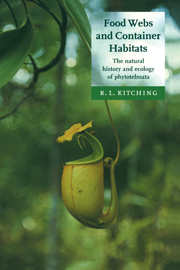Book contents
- Frontmatter
- Contents
- Preface
- 1 Introduction
- Part I The container flora, fauna and environment
- Part II Methods and theories
- 5 The construction and quantification of food webs
- 6 Processes structuring food webs
- Part III Patterns in phytotelm food webs
- Part IV Processes structuring food webs
- Part V Synthesis
- Annexe: The phytotelm bestiary
- References
- Index
6 - Processes structuring food webs
Explanatory theories and other ideas
Published online by Cambridge University Press: 26 August 2009
- Frontmatter
- Contents
- Preface
- 1 Introduction
- Part I The container flora, fauna and environment
- Part II Methods and theories
- 5 The construction and quantification of food webs
- 6 Processes structuring food webs
- Part III Patterns in phytotelm food webs
- Part IV Processes structuring food webs
- Part V Synthesis
- Annexe: The phytotelm bestiary
- References
- Index
Summary
Examine with me the fauna inhabiting a tree hole in the subtropical rainforest of south-east Queensland. First we must find a suitable tree: in general, in this forest, water-filled holes are commonest among the interdigitating buttress roots of any one of half a dozen species of tree. We should seek mature canopy trees to maximise our chances of finding such sites. The younger trees are not subject to the same forces of stress due to wind sheer and so do not have buttresses or water-filled hollows. Trees that are senescent have often had such holes during their mature years but now are old and in partial decay. The integrity of their bark is violated and most hollows formed are no longer watertight.
Having found a water-filled tree hole, we remove its contents and sort them into their various kinds and so construct a food web following the principles set out in Chapter 5. We can then calculate the various statistics that may characterise the community in this tree hole at the moment of its sampling. Of course the adjacent tree holes, although within the same patch of forest, are unlikely to possess exactly the same faunal components at the same levels of abundance. If we return to our selected tree hole at regular intervals we will see the species composition of the community change from time to time and the relative abundances of each faunal component will also vary.
Information
- Type
- Chapter
- Information
- Food Webs and Container HabitatsThe Natural History and Ecology of Phytotelmata, pp. 114 - 136Publisher: Cambridge University PressPrint publication year: 2000
